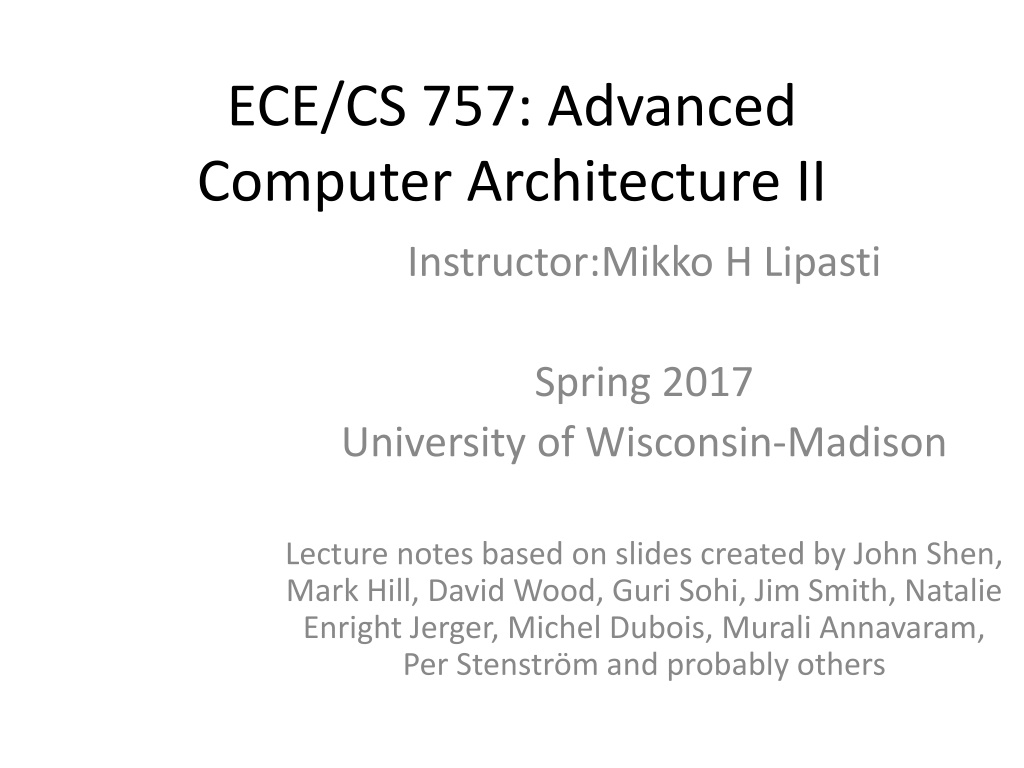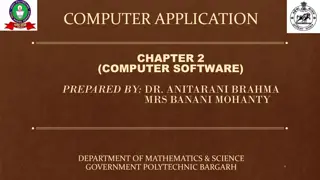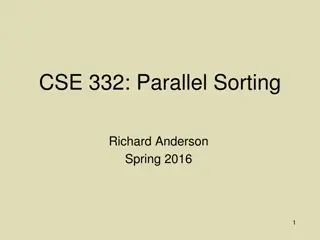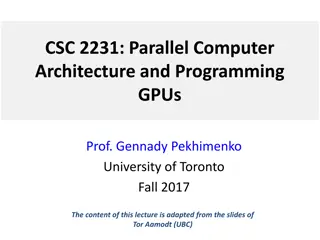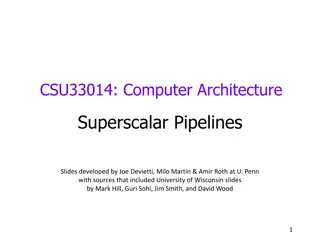Understanding Parallel Software in Advanced Computer Architecture II
Exploring the challenges of parallel software, the lecture delves into identifying and expressing parallelism, utilizing parallel hardware effectively, and debugging parallel algorithms. It discusses functional parallelism, automatic extraction of parallelism, and finding parallelism in various applications like games, signal processing, and web services.
Download Presentation

Please find below an Image/Link to download the presentation.
The content on the website is provided AS IS for your information and personal use only. It may not be sold, licensed, or shared on other websites without obtaining consent from the author. Download presentation by click this link. If you encounter any issues during the download, it is possible that the publisher has removed the file from their server.
E N D
Presentation Transcript
ECE/CS 757: Advanced Computer Architecture II Instructor:Mikko H Lipasti Spring 2017 University of Wisconsin-Madison Lecture notes based on slides created by John Shen, Mark Hill, David Wood, Guri Sohi, Jim Smith, Natalie Enright Jerger, Michel Dubois, Murali Annavaram, Per Stenstr m and probably others
Lecture Outline Introduction to Parallel Software Sources of parallelism Expressing parallelism Programming Models Major Abstractions Processes & threads Communication Synchronization Shared Memory API description Implementation at ABI, ISA levels ISA support Message Passing API description Implementation at ABI, ISA levels ISA support Mikko Lipasti-University of Wisconsin 2
Parallel Software Why is it so hard? Conscious mind is inherently sequential (sub-conscious mind is extremely parallel) Identifying parallelism in the problem Expressing parallelism to the hardware Effectively utilizing parallel hardware Balancing work Coordinating work Debugging parallel algorithms Mikko Lipasti-University of Wisconsin 3
Finding Parallelism 1. Functional parallelism Car: {engine, brakes, entertain, nav, } Game: {physics, logic, UI, render, } Signal processing: {transform, filter, scaling, } 2. Automatic extraction Decompose serial programs 3. Data parallelism Vector, matrix, db table, pixels, 4. Request parallelism Web, shared database, telephony, Mikko Lipasti-University of Wisconsin 4
1. Functional Parallelism 1. Functional parallelism Car: {engine, brakes, entertain, nav, } Game: {physics, logic, UI, render, } Signal processing: {transform, filter, scaling, } Relatively easy to identify and utilize Provides small-scale parallelism 3x-10x Balancing stages/functions is difficult Mikko Lipasti-University of Wisconsin 5
2. Automatic Extraction 2. Automatic extraction Decompose serial programs Works well for certain application types Regular control flow and memory accesses Difficult to guarantee correctness in all cases Ambiguous memory dependences Requires speculation, support for recovery Degree of parallelism Large (1000x) for easy cases Small (3x-10x) for difficult cases Mikko Lipasti-University of Wisconsin 6
3. Data Parallelism 3. Data parallelism Vector, matrix, db table, pixels, web pages, Large data => significant parallelism Many ways to express parallelism Vector/SIMD Threads, processes, shared memory Message-passing Challenges: Balancing & coordinating work Communication vs. computation at scale Mikko Lipasti-University of Wisconsin 7
4. Request Parallelism Web Browsing Users Web Server(s) Database Server(s) Multiple users => significant parallelism Challenges Synchronization, communication, balancing work Mikko Lipasti-University of Wisconsin 8
Balancing Work f 1 1-f Time Amdahl s parallel phase f: all processors busy If not perfectly balanced (1-f) term grows (f not fully parallel) Performance scaling suffers Manageable for data & request parallel apps Very difficult problem for other two: Functional parallelism Automatically extracted Mikko Lipasti-University of Wisconsin 9
Coordinating Work Synchronization Some data somewhere is shared Coordinate/order updates and reads Otherwise chaos Traditionally: locks and mutual exclusion Hard to get right, even harder to tune for perf. Research to reality: Transactional Memory Programmer: Declare potential conflict Hardware and/or software: speculate & check Commit or roll back and retry IBM, Intel, others, now support in HW Mikko Lipasti-University of Wisconsin 10
Expressing Parallelism SIMD introduced by Cray-1 vector supercomputer MMX, SSE/SSE2/SSE3/SSE4, AVX at small scale SPMD or SIMT GPGPU model (later) All processors execute same program on disjoint data Loose synchronization vs. rigid lockstep of SIMD MIMD most general (this lecture) Each processor executes its own program Expressed through standard interfaces API, ABI, ISA Mikko Lipasti-University of Wisconsin 11
MP Interfaces Levels of abstraction enable complex system designs (such as MP computers) Fairly natural extensions of uniprocessor model Historical evolution P r o g r a m m in g M o d e l U ser Applications M P API Language/Libraries Runtim e M P ABI O perating System M P ISA H ardw are Im plem entation (c) 2007 Jim Smith 12
Programming Models High level paradigm for expressing an algorithm Examples: Functional Sequential, procedural Shared memory Message Passing Embodied in high level languages that support concurrent execution Incorporated into HLL constructs Incorporated as libraries added to existing sequential language Top level features: For conventional models shared memory, message passing Multiple threads are conceptually visible to programmer Communication/synchronization are visible to programmer (c) 2007 Jim Smith 13
Application Programming Interface (API) Interface where HLL programmer works High level language plus libraries Individual libraries are sometimes referred to as an API User level runtime software is often part of API implementation Executes procedures Manages user-level state Examples: C and pthreads FORTRAN and MPI (c) 2007 Jim Smith 14
Application Binary Interface (ABI) Program in API is compiled to ABI Consists of: OS call interface User level instructions (part of ISA) P r o g r a m m in g M o d e l U ser Applications M P API Language/Libraries Runtim e M P ABI O perating System M P ISA H ardw are Im plem entation (c) 2007 Jim Smith 15
Instruction Set Architecture (ISA) Interface between hardware and software What the hardware implements Architected state Registers Memory architecture All instructions May include parallel (SIMD) operations Both non-privileged and privileged Exceptions (traps, interrupts) (c) 2007 Jim Smith 16
Programming Model Elements For both Shared Memory and Message Passing Processes and threads Process: A shared address space and one or more threads of control Thread: A program sequencer and private address space Task: Less formal term part of an overall job Created, terminated, scheduled, etc. Communication Passing of data Synchronization Communicating control information To assure reliable, deterministic communication (c) 2007 Jim Smith 17
sub-Outline Shared Memory Model API-level Processes, Threads API-level Communication API-level Synchronization Shared Memory Implementation Implementing Processes, Threads at ABI/ISA levels Implementing Communication at ABI/ISA levels Implementing Synchronization at ABI/ISA levels In order of decreasing complexity: synchronization, processes&threads, communication Repeat the above for Message Passing (c) 2007 Jim Smith 18
Shared Memory Flat shared memory or object heap Synchronization via memory variables enables reliable sharing Single process Multiple threads per process Private memory per thread Typically built on shared memory hardware system Shared Variables VAR . . . Thread 1 Private Variables w rite read Thread N Thread 1 Thread 2 (c) 2007 Jim Smith 19
Threads and Processes Creation generic -- Fork (Unix forks a process, not a thread) pthread_create( .*thread_function .) creates new thread in current address space Termination pthread_exit or terminates when thread_function terminates pthread_kill one thread can kill another (c) 2007 Jim Smith 20
Example Unix process with two threads (PC and stack pointer actually part of ABI/ISA implementation) User Address Space var1 var2 var3 ... thread 2 stack thread 2 PC var1 var2 var3 ... thread 1 stack thread 2 stack pointer m ain() thread1() thread 1 PC text (code) thread 1 stack pointer thread2() ... data structureA arrayB arrayC heap (c) 2007 Jim Smith 21
Shared Memory Communication Reads and writes to shared variables via normal language (assignment) statements (e.g. assembly load/store) (c) 2007 Jim Smith 22
Shared Memory Synchronization What really gives shared memory programming its structure Usually explicit in shared memory model Through language constructs or API Three major classes of synchronization Mutual exclusion (mutex) Point-to-point synchronization Rendezvous Employed by application design patterns A general description or template for the solution to a commonly recurring software design problem. (c) 2007 Jim Smith 23
Mutual Exclusion (mutex) Assures that only one thread at a time can access a code or data region Usually done via locks One thread acquires the lock All other threads excluded until lock is released Examples pthread_mutex_lock pthread_mutex_unlock Two main application programming patterns Code locking Data locking (c) 2007 Jim Smith 24
Code Locking Protect shared data by locking the code that accesses it Also called a monitor pattern Example of a critical section . . . Thread 1 Thread 2 Thread N update(args) mutex code_lock; ... lock(code_lock); <read data1> <modify data> <write data2> unlock(code_lock); return; Data Structure . . . Thread 1 Thread 2 Thread N (c) 2007 Jim Smith 25
Data Locking Protect shared data by locking data structure . . . Thread 2 Thread 1 Thread N lock(struct_lock); <read data1> <modify data> <write data1> unlock(struct_lock); lock(struct_lock); <read data2> <read data1> unlock(struct_lock); lock(struct_lock); <read data12> <modify data> <write data2> <write data1> unlock(struct_lock); . . . Thread 1 Thread 2 Thread N (c) 2007 Jim Smith 26
Data Locking Preferred when data structures are read/written in combinations Example: <thread 0> Lock(mutex_struct1) Lock(mutex_struct2) <access struct1> <access struct2> Unlock(mutex_data1) Unlock(mutex_data2) <thread 1> Lock(mutex_struct1) Lock(mutex_struct3) <access struct1> <access struct3> Unlock(mutex_data1) Unlock(mutex_data3) <thread 2> Lock(mutex_struct2) Lock(mutex_struct3) <access struct2> <access struct3> Unlock(mutex_data2) Unlock(mutex_data3) (c) 2007 Jim Smith 27
Deadlock Data locking is prone to deadlock If locks are acquired in an unsafe order Example: <thread 0> Lock(mutex_data1) Lock(mutex_data2) <access data1> <access data2> Unlock(mutex_data1) Unlock(mutex_data2) <thread 1> Lock(mutex_data2) Lock(mutex_data1) <access data1> <access data2 Unlock(mutex_data1) Unlock (mutex_data2) Complexity Disciplined locking order must be maintained, else deadlock Also, composability problems Locking structures in a nest of called procedures (c) 2007 Jim Smith 28
Efficiency Lock Contention Causes threads to wait Function of lock granularity Size of data structure or code that is being locked Extreme Case: One big lock model for multithreaded OSes Easy to implement, but very inefficient Finer granularity + Less contention - More locks, more locking code - perhaps more deadlock opportunities Coarser granularity opposite +/- of above (c) 2007 Jim Smith 29
Point-to-Point Synchronization One thread signals another that a condition holds Can be done via API routines Can be done via normal load/stores Examples pthread_cond_signal pthread_cond_wait suspends thread if condition not true Application program pattern Producer/Consumer <Producer> while (full ==1){}; wait buffer = value; full = 1; <Consumer> while (full == 0){}; wait b = buffer; full = 0; (c) 2007 Jim Smith 30
Rendezvous Two or more cooperating threads must reach a program point before proceeding Examples wait for another thread at a join point before proceeding example: pthread_join barrier synchronization many (or all) threads wait at a given point Application program pattern Bulk synchronous programming pattern (c) 2007 Jim Smith 31
Bulk Synchronous Program Pattern Thread 1Thread 2 . . . Thread N Compute Barrier Communicate Compute Barrier Communicate Compute (c) 2007 Jim Smith 32
Summary: Synchronization and Patterns mutex (mutual exclusion) code locking (monitors) data locking point to point producer/consumer rendezvous bulk synchronous (c) 2007 Jim Smith 33
sub-Outline Shared Memory Model API-level Processes, Threads API-level Communication API-level Synchronization Shared Memory Implementation Implementing Processes, Threads at ABI/ISA levels Implementing Communication at ABI/ISA levels Implementing Synchronization at ABI/ISA levels In order of decreasing complexity: synchronization, processes&threads, communication Repeat the above for Message Passing (c) 2007 Jim Smith 34
API Implementation Implemented at ABI and ISA level OS calls Runtime software Special instructions P r o g r a m m in g M o d e l U ser Applications M P API Language/Libraries Runtim e M P ABI O perating System M P ISA H ardw are Im plem entation (c) 2007 Jim Smith 35
Processes and Threads Three models OS processes OS threads User threads (c) 2007 Jim Smith 36
OS Processes Thread == Process Use OS fork to create processes Use OS calls to set up shared address space (e.g. shmget) OS manages processes (and threads) via run queue Heavyweight thread switches OS call followed by: Switch address mappings Switch process-related tables Full register switch Advantage Threads have protected private memory (c) 2007 Jim Smith 37
OS (Kernel) Threads API pthread_create() maps to Linux clone() Allows multiple threads sharing memory address space OS manages threads via run queue Lighter weight thread switch Still requires OS call No need to switch address mappings OS switches architected register state and stack pointer (c) 2007 Jim Smith 38
User Threads If memory mapping doesn t change, why involve OS at all? Runtime creates threads simply by allocating stack space Runtime switches threads via user level instructions thread switch via jumps User Address Space var1 var2 var3 ... thread 2 stack thread 2 PC var1 var2 var3 ... thread 1 stack thread 2 stack pointer m ain() thread1() thread 1 PC text (code) thread 1 stack pointer thread2() ... data structureA arrayB arrayC heap (c) 2007 Jim Smith 39
Implementing User Threads Multiple kernel threads needed to get control of multiple hardware processors Create kernel threads (OS schedules) Create user threads that runtime schedules onto kernel threads User Threads Runtime Scheduler User Thread Queue Kernel Threads OS Scheduler Kernel Thread Queue Processor 1 Processor 2 Processor N (c) 2007 Jim Smith 40
Implementing User Threads User Threads Runtime Scheduler User Thread Queue Kernel Threads OS Scheduler Kernel Thread Queue Processor 1 Processor 2 Processor N (c) 2007 Jim Smith 41
Communication Easy Just map high level access to variables to ISA level loads and stores Except for Ordering of memory accesses -- later (c) 2007 Jim Smith 42
Synchronization Implement locks and rendezvous (barriers) Use loads and stores to implement lock: <thread 0> . . LAB1: Load R1, Lock Branch LAB1 if R1==1 Ldi R1, 1 Store Lock, R1 . <critical section> . Ldi R1, 0 Store Lock, R1 <thread 1> LAB2: Load R1, Lock Branch LAB2 if R1==1 Ldi R1,1 Store Lock, R1 . <critical section> . Ldi R1, 0 Store Lock, R1 . . (c) 2007 Jim Smith 43
Lock Implementation Does not work Violates mutual exclusion if both threads attempt to lock at the same time In practice, may work most of the time Leading to an unexplainable system hang every few days <thread 0> LAB1: <thread 1> LAB2: Load R1, Lock Branch LAB2 if R1==1 Ldi R1,1 Store Lock, R1 . . Load R1, Lock Branch LAB1 if R1==1 Ldi R1, 1 Store Lock, R1 . . (c) 2007 Jim Smith 44
Lock Implementation Reliable locking can be done with atomic read-modify-write instruction Example: test&set read lock and write a one some ISAs also set CCs (test) <thread 1> LAB1: <thread 2> LAB2: Test&Set R1, Lock Branch LAB2 if R1==1 . <critical section> . Reset Lock . Test&Set R1, Lock Branch LAB1 if R1==1 . <critical section> . Reset Lock . (c) 2007 Jim Smith 45
Atomic Read-Modify-Write Many such instructions have been used in ISAs Test&Set(reg,lock) Fetch&Add(reg,value,sum) reg mem(lock); reg mem(sum); mem(lock) 1; mem(sum) mem(sum)+value; Swap(reg,opnd) temp mem(opnd); mem(opnd) reg; reg temp More-or-less equivalent One can be used to implement the others Implement Fetch&Add with Test&Set: try: Test&Set(lock); if lock == 1 go to try; reg mem(sum); mem(sum) reg+value; reset (lock); (c) 2007 Jim Smith 46
Sub-Atomic Locks Use two instructions: Load linked + Store conditional Load linked reads memory value sets special flag writes address to special global address register Flag cleared on operations that may violate atomicity (implementation-dependent) e.g., write to address by another processor can use cache coherence mechanisms (later) context switch Store conditional writes value if flag is set no-op if flag is clear sets CC indicating or failure (c) 2007 Jim Smith 47
Load-Linked Store-Conditional Example: atomic swap (r4,mem(r1)) try: mov r3,r4 ll r2,0(r1) sc r3,0(r1) beqz r3,try mov r4,r2 RISC- style implementation Like many early RISC ideas, it seemed like a good idea at the time register windows, delayed branches, special divide regs, etc. ;move exchange value ;load locked ;store conditional ;if store fails ;load value to r4 (c) 2007 Jim Smith 48
Lock Efficiency Spin Locks tight loop until lock is acquired LAB1: Test&Set R1, Lock Branch LAB1 if R1==1 Inefficiencies: Memory/Interconnect resources, spinning on read/writes With a cache-based systems, writes lots of coherence traffic Processor resource not executing useful instructions (c) 2007 Jim Smith 49
Efficient Lock Implementations Test&Test&Set spin on check for unlock only, then try to lock with cache systems, all reads can be local no bus or external memory resources used test_it: load lock_it: test&set reg, mem(lock) test_it if reg==1 reg, mem(lock) test_it if reg==1 branch branch Test&Set with Backoff Insert delay between test&set operations (not too long) Each failed attempt longer delay (Like ethernet collision avoidance) (c) 2007 Jim Smith 50
